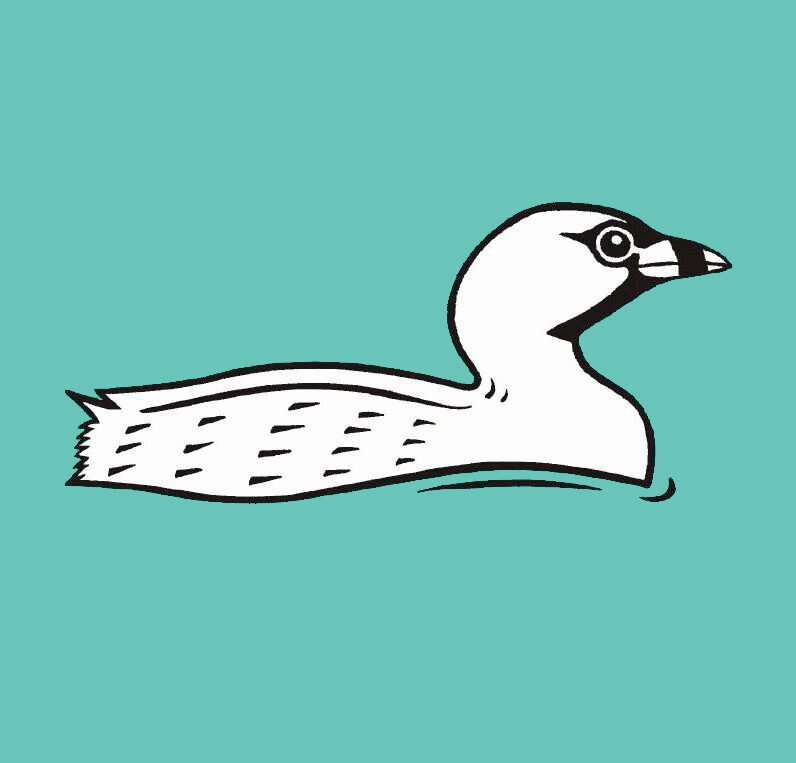
BOC Holidays
Asturia 8th to 13th Sept 2025 ASTURIA – Full Report
31 January to 2nd February – Poole Harbour Leader: Nick Page
21 of us left Bristol heading to Poole Harbour. Our first stop was Upton Park which is a council owned public space with a walled garden, woodland and a view over Holes Bay. Here we saw Avocet, Pintail and Snipe among other wetland and woodland species. On to Hamworthy Park to see the long-staying Snow Bunting. We found it hopping about on the sea-front path oblivious to the onlooking birders but less tolerant of loose dogs. Finally, a short stop at Ham Common near Rockly Sands caravan park where we saw Common Scoter in the distance. The first stop on Saturday was Jerry’s Point at Studland. We saw Brent Goose, Shag, Great Northern Diver, Great – crested Grebe, Long-tailed Duck, Spoonbill and Grey Plover. Many Red-breasted Mergansers provided some colour. We spent most of the day at RSPB Arne. The Shipstal trail gave us more looks at Pintail, Avocet, Spoonbill, Red-breasted Merganser and several Black-necked Grebes. The feeders around the car park and visitors centre had Coal Tit, Siskin and many other visiting birds. After lunch we did the Coombe Heath loop where we saw Ruff, and a White-tailed Eagle graced the skies before gliding off towards Corfe. There was a distinct lack of small birds on the heath, but there was a small group of Meadow Pipit. The conditions also put off most of the raptors, except one Kestrel. On Sunday we joined the excellent Birds of Poole Harbour Safari boat trip. This allowed us to explore much of the harbour from Poole Quay, and then round the islands. Sightings included Marsh Harrier, several Great Northern Divers, five Black-necked Grebes, and many waders including Black-tailed and Bar-tailed Godwits, Knot and Sanderling. Stonechat and Kingfisher added some passerine interest. A Ruddy Shelduck (of dubious provenance) was seen flying with a Shelduck.On the way home at Bonsley Common, we saw Skylark, Linnet, winter thrushes, Yellowhammer and Woodlark. We found a large Chaffinch flock containing several Brambling s which were tricky to separate in poor light but some members of the group picked them out. The trip list ended on 103 species, plus the Ruddy Shelduck. A full list of birds is viewable on this link. Many thanks to Alastair for his advice, help with this write up, and for leading on Friday; to Peter and Jeremy for driving the minibus, and to all who came along and made my first BOC trip so enjoyable. (Thanks to Nick for leading) Nick Page
Dorset trip 31 Jan – 2 Feb 2025 with Photos Leader Nick Page
The report can be found here
24 April to 01 May – Isles of Scilly Leader: Jane Cumming
Fifteen BOC members travelled to the Isles of Scilly, most taking the ‘Scillonian III’ ferry from Penzance. The sea was calm for the crossing and we were immediately rewarded by four Eider in Penzance harbour and a few Great Northern Divers. As the crossing progressed we saw large numbers of Manx Shearwater, Gannets, Shags and a Fulmar. We were advised a distant stiff dorsal fin belonged to a Risso’s Dolphin. After checking in at the ‘Mincarlo’ guest house, sited overlooking the harbour at Hugh Town, we all walked up the ‘main’ road towards Higher Moors and Porth Hellick where the hoped for Woodchat Shrike gave us a prominent view in a hedgerow.
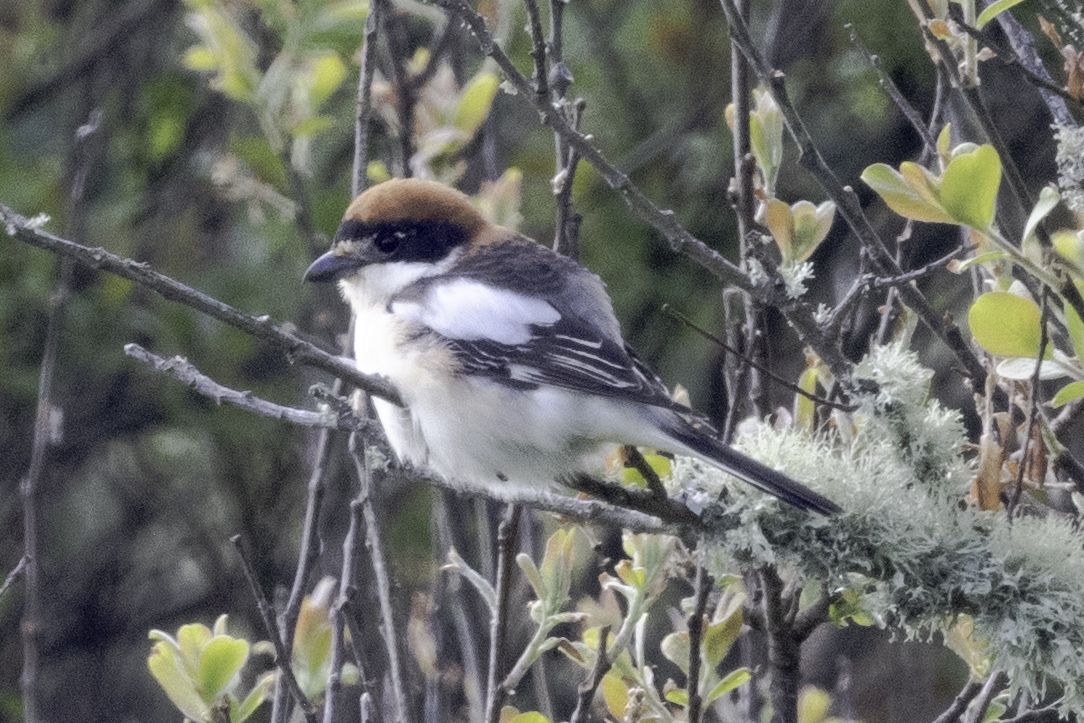
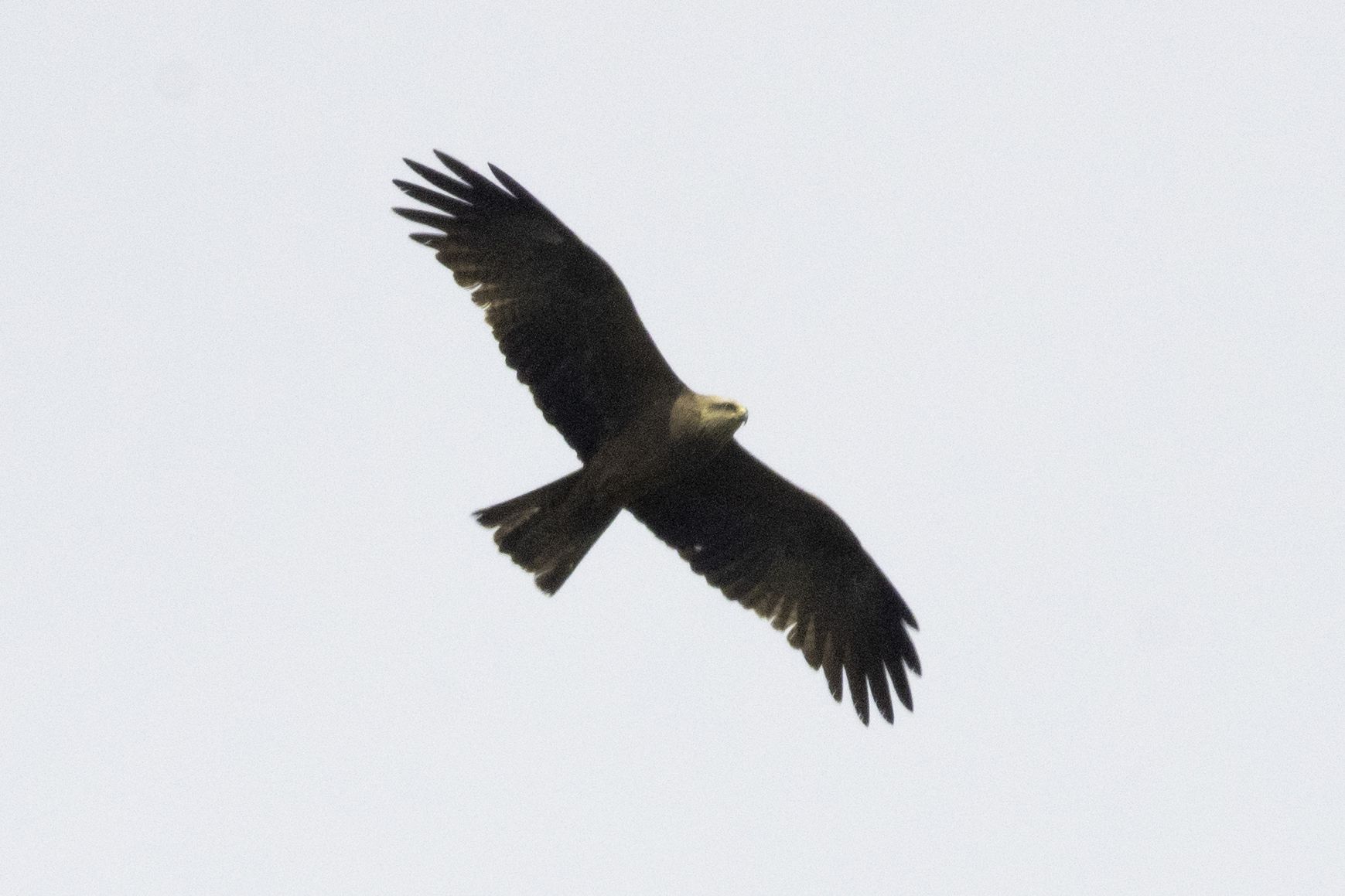
A distant Black Kite was seen and a Peregrine whizzed by. Walking around Porth Hellick bay Grey Seals were inquisitive and we saw the first of a great number of Whimbrel and Wheatear on passage through all the islands as well as a Grey Heron. The Lower Moors path returning to Hugh Town ticked off the expected warblers; Willow, Cetti’s, Sedge, Reed and Blackcap. Sand Martins and Swallows were overhead and very tame Song Thrushes and flocks of Linnets were constant companions. Thanks to Robin for taking such excellent photos and sharing them over our holiday WhatsApp group each evening before dinner, including a warbler quiz.
Day 2. We caught the bus up the hill to explore the Neolithic burial chambers at Halangy Down. On the coast we saw Ringed Plover and Bar-tailed Godwits and inland Firecrest and Goldcrest were spotted by a few along with our first House Martins. On a tip-off, a late visit to Lower Moors added a Siberian Chiffchaff before dinner.
Day 3. A damp crossing to Tresco where the inland pools provided Pochard, Gadwall, Shoveler, Tufted Duck, Coot, Mute Swan and Black-headed Gull. An unusually visible Reed Warbler had made Abbey Pool its home. Pentle Bay was a good spot for waders where Jane counted 21 Turnstone, 18 Dunlin and c.30 Ringed Plovers along with Whimbrel, Shelduck and more Great Northern Divers off-shore. Robert and Ian disturbed a Short-eared Owl hunting in the dunes which circled giving great views of its ‘catty face’. The Abbey provided Red Squirrels and a Lady Amerhurst’s Pheasant. Those that made the trip north over the moor didn’t find the reported Ring Ouzel or Grasshopper Warbler but all who made it that far agreed how excellent King Charles’s and Cromwell’s castles were. A Whitethroat was also heard.
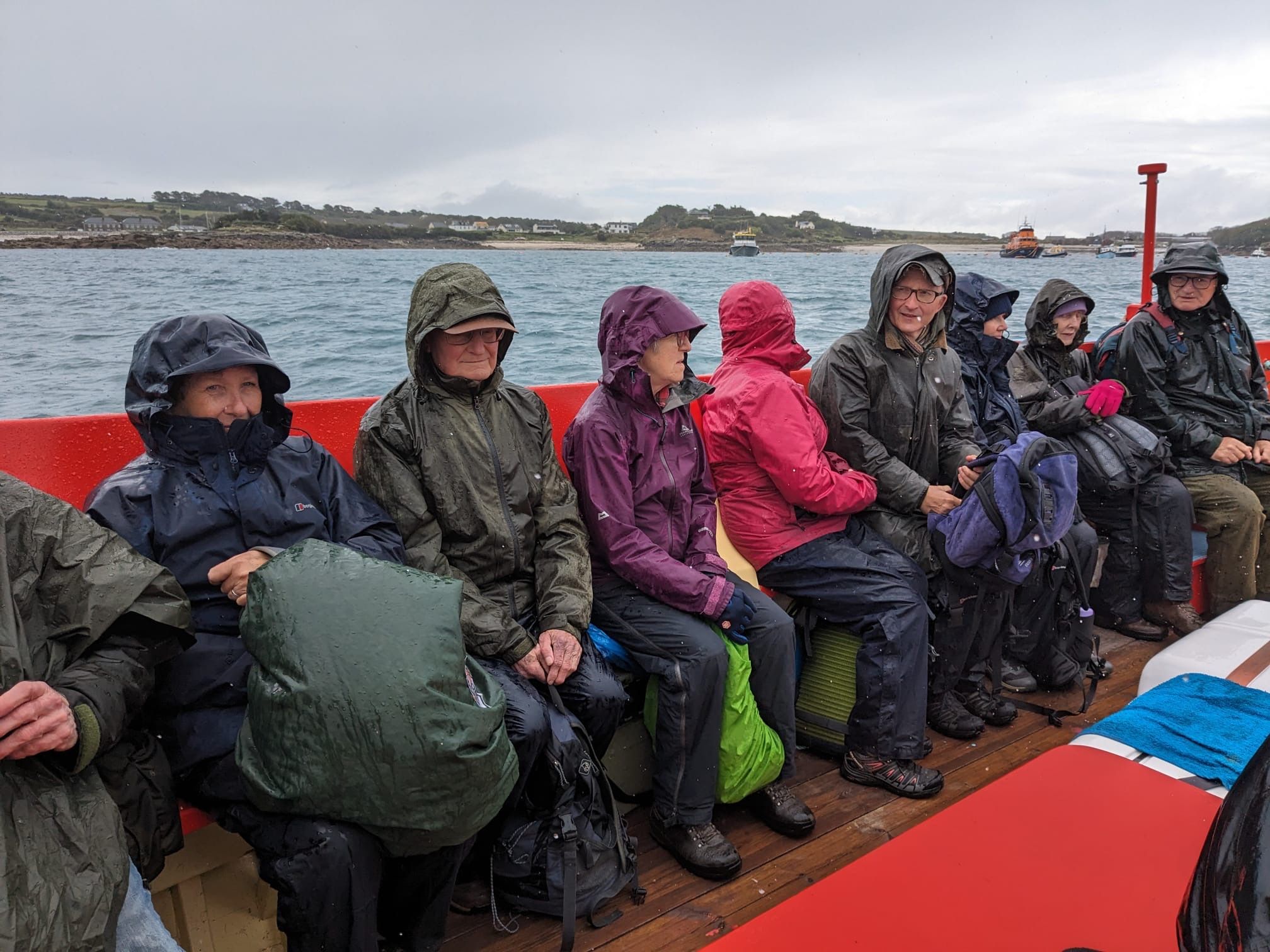
Day 4. A pre-breakfast walk by one of our group to Carreg Dhu garden was rewarded with hearing a reported Golden Oriole singing. After breakfast another damp boat trip out to the Western Isles and Annet en route to St Agnes to see nesting Puffins along with Razorbills and Guillemots. Also, excellent views of Grey Seals. Some hard core twitchers made a soggy dash from the St Agnes quay straight for the craggy and wild Wingletang Down where a Stone Curlew had been reported. The BOC group sheltered waiting for the rain to subside before some headed for the cafe and a warm up. The improving weather brought great views of many Wheatears, Rock Pipits and more Whimbrel as well as Ringed Plover. The Stone Curlew was in hiding from the deluge of birders but a Red-legged Partridge was sighted.
Day 5. Sunday brought dry and sunny weather for a trip to Tresco and wildlife watching with Will Wagstaff detouring around the Tresco coast to Round Island. Some rocks off Tresco gave us a selection of waders including 65 plus Sanderling, an expertly found group of six Purple Sandpipers and a fly past from our first Curlew (also Barwits, Turnstones, Great Northern Divers in summer and winter plumage, Gannets in water). A queasy bob around Round Island added to the Puffin count and gave memorable views of Fulmars. The sunshine on Tresco didn’t bring any more ticks other than a singing Cuckoo beyond New Grimsby.
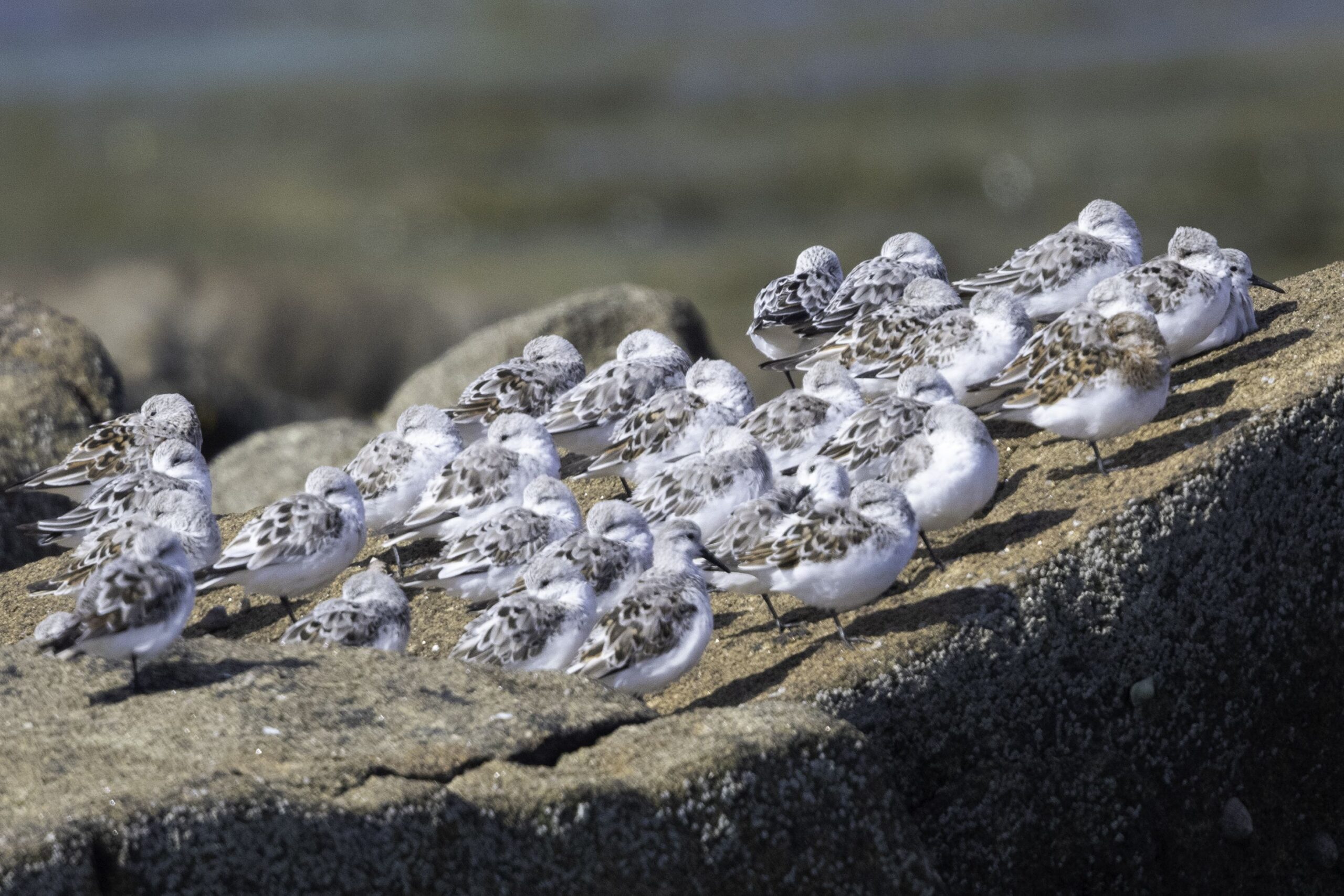
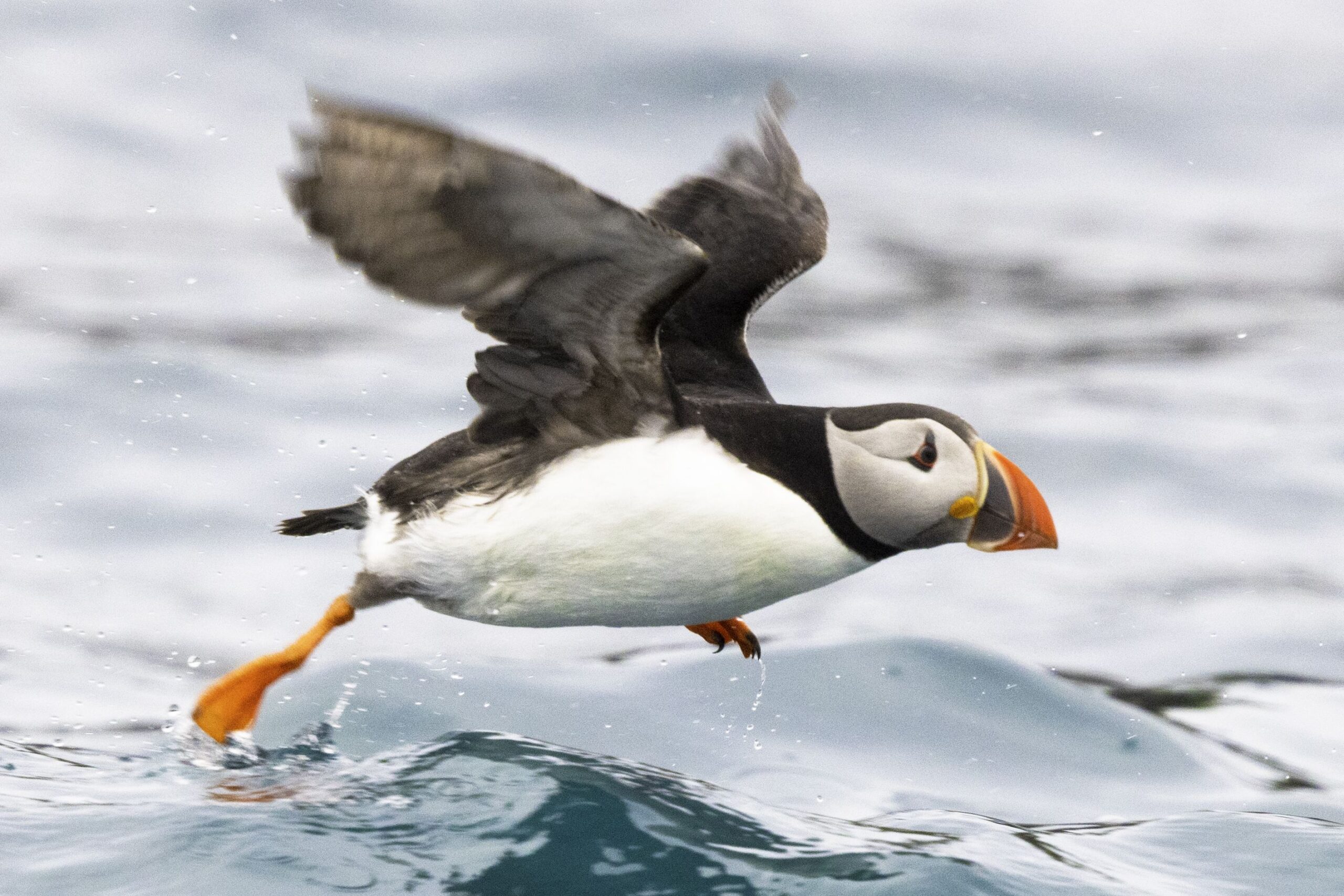
Day 6. A rainy Monday meant opportunities for birding were limited.
Day 7. Our group split between making the crossing to St Martin’s or staying on St Mary’s to chase some reported twitches. Simultaneously, Ian and Paul saw similar looking Harriers on both the islands which were later confirmed as a female Montagu’s on St Martin’s and a female Hen Harrier on St Mary’s. A Golden Plover was spotted on St Mary’s airfield.
Day 8. Robin and Jill headed to Bryher to look for a Short-toed Lark, no luck, but did have another sighting of the Montagu’s Harrier. Back on St Mary’s, Ian had a beach level fly-past by a Waxwing which landed ahead, apparently not recently reported but known to have been about for a while. Our last afternoon also coincided with the exciting build up to the annual gig racing championships cramming the streets with gigs and athletic, bronzed non-birders (probably). Our more leisurely voyage east to Penzance gave us views of Bottlenose Dolphins and jumping Blue-fin Tuna along with a constant stream of Manx Shearwaters heading west to their nesting sites.
Many thanks to Jane for organising and leading the birding and culinary aspects of the trip so expertly and to the staff at the ‘Mincarlo’ for excellent service and hospitality during our stay. 91 species were seen or heard during the trip (excluding Lady Amerhurst’s Pheasant and Siberian Chiffchaff). Ian Price
20 – 27 March – BOC trip to Portugal – Lisbon, Alentejo and the Algarve Tour guides: João Jara (first day), António Cotáo, Miguel Rodrigues Organiser: Alastair Fraser
THE REPORT CAN BE FOUND HERE
https://bristolornithologicalclub.co.uk/wp-content/uploads/2024/06/BOC-trip-Portugal-2024.pdf
23 – 26 February – BOC West Cornwall Trip Leader: Jane Cumming
Twelve of us met on Friday morning and after loading our minibus we headed for the Hayle estuary, arriving just before high tide to see a good variety of gulls and shore birds. These included two Knot, two Dunlin and groups of Redshank, Goosander, Teal, Turnstones and ‘barwits’. Across the road in RSPB Ryan’s Field we enjoyed a first winter Spoonbill (its ring indicated it had come from Belgium or Holland), a Little Egret, many Redshanks, a displaying Greenshank and an adult and juvenile Curlew (helping us to compare their bill lengths). We drove on to the moorland south of St Just, where we were delighted that a putative hare turned out to be a Short-eared Owl, soon joined by another, hunting over the rough pasture. We stayed at Bosavern House, south of St Just. Helen Stevens opened specially for us and looked after us
wonderfully well with generous meals, a good selection of drinks, and comfortable rooms. Here we were joined by two others, making 14 in all. Saturday morning was bright and breezy. After a full breakfast we set off for the coast, starting at Pendeen Watch and going on to Cape Cornwall and Sennen Cove. Our hopes of seeing Choughs were met more than once; sea watching produced auks, gulls and Gannets, and there were Fulmars and Kittiwakes on the cliffs, and gulls,
Oystercatchers and Curlew on the rocks. The sea was majestic, complete with the occasional rainbow. After a lunch stop at Drift Reservoir (many gulls and Canada Geese in the distance), we drove on to Sandy Cove at Newlyn, where we saw more auks as well as a good range of garden birds in the bushes along the coast path, and a Rock Pipit – on the rocks! Then we returned to the estuary at Hayle, and at Lelant Saltings Station we saw a second winter Kumlien’s Gull and a Ring-billed Gull amongst crowds of other gulls on the mud flats, along with ‘barwits’, Redshank, Oystercatchers, Curlew, Shelduck and male and female Goosanders, Teal and Wigeon. On
Carnsew Basin we saw a Mediterranean Gull, Cormorant and three Little Grebes. Our last stop was at Penzance quay where we enjoyed Turnstones flying across the harbour, and many Starlings coming to roost (rather precariously) on the flagpole cable stays and stone pinnacles of the church tower. Our focus on Sunday was the south coast, from Marazion east to the freshwater Loe Pool. At Marazion marsh we got excellent views of a Firecrest, Reed Bunting, Chiffchaff, Stonechats, three Mute Swans, Canada Geese and three Bullfinches, as well as distant views of Snipe, four Grey Herons, Mallard and Teal. We also heard several Cetti’s warblers. The beach had 47 Sanderlings. At Perranuthnoe we saw flocks of Pied Wagtails in and above the vegetable fields, and sea watching produced eight Great Northern Divers. We stopped at Helston Boating Lake and added three Shovelers and numerous Tufted Ducks to our list. We then drove to Tye Rocks near Porthleven (two Raven, Stonechats; and at sea auks and Shags). On our walk after lunch along the coastal path to Loe Bar (about a mile) we had a close view of a female Kestrel. On the drive back to Bosavern House we stopped to admire the Short-eared Owls again; these were joined by a Buzzard and a female Hen Harrier – a magnificent sight. Monday morning saw us trekking in the stiff breeze along a muddy field footpath two miles west of Penzance,
looking for a Little Bunting. Instead we saw several hundred Chaffinches with a few Linnets, Ravens, a Sparrowhawk and three Buzzards. Marazion beach produced more gulls and a (surprising) Goosander on the sea. As on the first three days, this day ended on a high note. Scanning Carrick Roads from Feock beach we were entertained by ten Red-breasted Mergansers displaying to each other (and to us!), and then we tracked a vagrant juvenile Surf Scoter drifting across the bay. Finally, we took the ferry across the River Fal to the Roseland peninsula and continued our sea watching at Gerrans Bay in perfect calm, sunny conditions; here we saw about
15 Black-throated Divers and a Common Scoter. We got back to Bristol at 20:00, so grateful for a wonderful birding exploration of West Cornwall, for our excellent drivers Paul and Peter, and for all Jane did in making the arrangements and leading us so capably. Some 92 bird species were seen by two or more of us. David Gould
Friday 03 – Sunday 05 November – South Devon Weekend Leader: Jane Cumming
Seventeen BOC members braved the aftermath of Storm ‘Ciaron’ which had passed through on the previous day.
Friday: Our first stop on the way down was at Steps Bridge, about ten miles south west of Exeter. Unfortunately, not many birds were around, but we saw three Goldcrests together in the trees. Goosander and Magpie were also seen. Undeterred, we continued to Bowcombe Creek near Kingsbridge. There we saw Redshank, Mallard, Grey Heron, Little Egret, Black-headed and Herring Gull, Cormorant in the creek and Coal, Blue and Long-tailed Tit in the trees as well as a Raven overhead. But the highlight for many of us was a Kingfisher fishing on the far side of the creek and for others a Greenshank on the creek’s sand bank. So, satisfied with the day’s birding, we set off to the Cottage Hotel in Hope Cove with its splendid views of the sea and coves.
Saturday: We set off early to Slapton Ley and walked round the nature reserve at the far end. There we saw Tufted Duck, Coot, Moorhen, Great Crested Grebe, one Gadwall, Mute Swan, Grey Heron and Collared Dove. A Water Rail was heard but not seen. Many gulls out on the water, Black-headed, Common, Herring and Great Black-backed Gulls were busy washing and preening themselves in the fresh water of the ley. To everyone’s delight an otter was seen swimming on the far side. We proceeded to the Torcross end of Slapton Ley and looked out over both the sea and ley. Gannets were gliding in graceful sweeps overhead, their black wing tips and large beaks clearly visible. Crows mobbed a Short-eared Owl quite close to us, the highlight of the day. Little Egret and a Great White Egret were seen on the ley. From there we went to Beesands and watched the Gannets again, also Stonechat, Meadow Pipit and Pied Wagtail. We continued on to Thurlestone Sands, first stopping at a car park on the northern headland. The sea was quite wild, with huge waves breaking across the rocks. Turnstone and Rock Pipit were spotted there and a Kestrel hovered in the strong wind overhead. Further on by the reeds towards South Milton Sands, Buzzard, Chiffchaff, Cetti’s Warbler (only heard), Skylark, Blue Tit, Great Tit, Long-tailed Tit, Goldcrest, Wren, Dunnock, and Goldfinch were seen. Our last stop was at South Milton Sands at the southern end of Thurlestone Bay. There were Wigeon, Mallard, Canada Geese and Teal around the lagoon. A flock of about 20 Starling swooped several times before landing to roost among the reeds.. Six Oystercatchers were counted bobbing away, calling plaintively, on the rocks on the beach. Cormorant and Shag were also seen. We headed back to Hope Cove to our lovely hotel and another first-rate five course dinner.
Sunday: We headed to Prawle Point with the intent of seeing Cirl Bunting and amazingly found two straight away. A Short-eared Owl was mobbed by Crows again and two Peregrine were seen. A Kestrel was spotted far away on the cliffs and Stonechat and one more Cirl Bunting in some of the bushes. Several flocks of Woodpigeons totalling at least 320 were passing overhead, migrating, probably to northern France. Our next stop was the breakwater at Brixham. Almost immediately we saw a Great Northern Diver quite close to shore which stayed near the breakwater as it swam further offshore. Three Purple Sandpipers were near the far end, and about 20 Turnstone were spotted en route. I thought I had missed these, but found one had interloped into my Sandpiper photos. A Common Seal was sunning itself near the sandpipers and several others were out of the water near the marina. Two or three Gannet were around, one feeding so we could enjoy its spectacular diving skills. Rock Pipit dabbled around the shore when we got back to the car park. Finally we headed towards the Labrador Bay RSPB Reserve, set up to attract Cirl Bunting. Two Great Northern Divers were seen down in the bay. Unfortunately our luck with the weather ran out and it started to rain very heavily. The light was also fading. Time to go home.
Thank you to our leader, Jane who organized the trip. We saw some brilliant birds and we managed to miss the rain nearly everywhere. The highlights for me were seeing the Short-eared Owl and the otter (not a bird I know but still a wonderful sign of thriving wildlife.) It was a very enjoyable trip with a total of 72 species. Alison Hooper
Pembrokeshire, 17 – 21 April. Leader: Colin Hunt
Eleven car sharing members were based in Freshwater East west of Tenby, weather often chilly but dry.
First stop on our way was Llanelli Wetlands Centre, Slimbridge-inspired with large areas of pool, reed and scrub close to the coast. Sightings (excluding the many foreign water fowl!) included 300 plus Black-tailed Godwits, 30 plus Knot, Lapwings, Greenshank, a juvenile? Long-tailed Duck in intermediate plumage and without the long tail feathers, juvenile Spoonbill, Pochard, a group of eight Mediterranean Gulls amidst Black-headed (including one Black-headed with a striking pink front – an oddity possibly indicating a Swedish-based shrimp diet…) Whitethroat, Blackcaps, Chiffchaffs, Willow Warblers, many Cetti’s, Meadow Pipits, Reed Bunting. Lots of mating pairs, a Great Crested Grebe pair on a nest and Mallards with five chicks.
The following day we had the tricky drive to Martin’s Haven on Wales’ south-west tip, for the ferry to Skomer Island. Waiting watchers saw/heard Swallows, Blackcaps, Whitethroat, Skylarks, Raven – and Ring Ouzels; then a short boat ride (including views of Common Dolphin? and Harbour Porpoise) and a hard trudge up took us onto this almost treeless island less than three kilometres square raised 60 metres above the Atlantic, with much of its surface punctured with Puffin and Manx Shearwater burrows like a mini WW1 battlefield. The harbour waters were full of Guillemot and Puffins (the latter not yet on their nests), and a small flock of Kittiwake. We scattered in different directions to see and hear Willow Warblers, Blackcaps, Wheatears galore, a single House Martin, five Whimbrel put up by a Peregrine, Choughs, Buzzards, and Fulmars and Gannets down precipitous cliffs. A small inland pool housed a surprise pair of Shovelers, and a few people had great close-ups of a female Ring Ouzel with subtle pale brown throat crescent and silvery feather patterns distinct in the sunshine. Sadly, the paths were also littered with the bones and feathers of Manx Shearwaters who had already fallen prey to hungry predators. An information board showed the huge numbers of these (350,000) and other breeding pair species that have been logged on the island in previous years. The third day started at Bosherton Lily Ponds (part of the Stackpole Estate west of Freshwater East), with long valley lakes (home to Otters, one of which we briefly glimpsed), running through woodland before emerging onto Broad Haven beach. Plenty more warblers – Willow, Chiffchaff, Blackcap, Whitethroat – Song Thrush, Bullfinch, Moorhen and Mallard, Grey Heron and Swan, our first Red Kites, and a surprise Gannet diving almost at the shoreline on the beach.
We continued west along the coast to Freshwater West, a long isolated surfing beach and dunes guarded by military areas, to see a scattering of Gannets and Curlews; then inland to the tiny village of Angle on a muddy gravelly creek and cove overlooking Milford Haven. Here some dedicated wader watching found Curlews, Whimbrels with their proportionately shorter bills and striped heads, Oystercatchers, Dunlins, and possibly a Little Ringed Plover (we think we saw pale legs…).
We ended back on the dramatic vertical cliffs at St Govan’s Head just west of Stackpole with lovely close views of Choughs on the grass, Kestrel above, and Guillemots, Razorbills and Manx Shearwaters on the sea 60 metres below with Common Dolphins sporting amongst them. Next day we explored locally, starting at Freshwater East beach, then the wetland reserve of reed and wet woodland that ran up the valley behind, and adjacent reserve through dunes and meadows behind the beach. The wetlands had most of the warblers we had already heard plus a Reed Warbler (song indentified after some intense listening); adjacent areas included Bullfinches, Grey Heron, Buzzard and Kestrel; and sea watches found two Red-throated Divers in the surf – pretty pale grey plumage and obvious upturned bills – Guillemot, a Bar-tailed Godwit in breeding plumage, two Whimbrels, and two fine Sandwich Terns.
Finally some of the group explored an adjacent deep valley woodland reserve memorably called Scraggy Bottom, finding Nuthatch, Pheasant, Great Spotted Woodpecker, Raven and Sparrowhawk.
We spent our last morning on a cliff walk round St Govan’s Head, watching small groups of Razorbills on the sea, Shags on rocks displaying their fine breeding crests, Great Black-backed Gulls, Fulmars, a flying winter plumage Bar-tailed Godwit, a hunting Peregrine, a close-up Kestrel perched on the cliff face – and above and in the gorse-rich heathland – Swallows, House Martins, Wheatears, loudly-singing Whitethroat, Skylark, Linnets, Meadow Pipits, Raven and some slightly surprising Dunnocks.
Many thanks to Colin for organising and leading us on this new trip in an area he knows well: and to Judy Copeland for all her associated help. Total species: 100. Lois Pryce
Club Holiday to North-east Poland 3 – 11 May – Leader William Earp
A comprehensive 44 page report can be found at – Full Trip Report
This much postponed trip, originally scheduled for 2020, finally took place this year. Seven Club members, plus a welcome addition from the North-east Norfolk Bird Club, were met by eminent Polish naturalist and conservationist Marek Borkowski at Warsaw Chopin Airport, and immediately taken to a park close by where the first birds seen were a pair of Syrian Woodpeckers, followed by a Short-toed Treecreeper as we were enjoying a reviving picnic.
From the town of Rajgrod, our base for the first five nights, we were taken to various sites in the Biebrza Marshes, starting with Marek’s ‘garden’. Readers might remember Marek describing its special delights when he gave a talk to the Club in 2017. Highlights of this part of the trip included White-backed and Grey-headed Woodpeckers, Great Reed and Savi’s Warblers, a pair of Little Crakes, Pygmy and Tengmalm’s Owls. Thrush Nightingales were everywhere though hard to see. Hawfinch and Red Squirrel were regular visitors to Marek’s bird table. A pretty village held a pair of singing Wryneck with Ortolan Bunting on telegraph wires not far away. Raptors included White-tailed and Lesser Spotted Eagles – oh, and a Greater Spotted Eagle as bonus. Stretches of marshes and waterlogged meadows were patrolled by Whiskered, White-winged Black and Black Terns while on the ground were large, loose flocks of Wood Sandpiper and Ruff, the jousting males in their full breeding finery looking just like the illustration in the Collins Field Guide. We spent some time trying, and eventually succeeding, to get to see the super-rare Aquatic Warbler which breeds in boggy meadows in this part of the world – it is Europe’s most rapidly declining warbler. It also sings mainly in the evening. Best of all, we felt, was a night-time excursion to view the other regional speciality, Great Snipe, at its lek. We were privileged to get extended views by torchlight of this remarkable performance as we played a version of ‘Grandmother’s Footsteps’, creeping up to get ever closer to the birds.
In the Bialowieza Forest we stayed in a memorable place, a railway station built originally for the Tsar of Russia and now lovingly restored and converted into a bijou hotel. It’s as close as you can get to the border with Belarus. Hard to convey what it is like: the nearest local equivalent, perhaps, might be the SS Great Britain. The surrounding trees had Golden Oriole and Scarlet Rosefinch. In the Forest we managed Middle Spotted and Three-toed Woodpeckers and a singing Barred Warbler. Collared Flycatchers were quite frequent. We tried to entice some of the Corncrakes which we were hearing to come out and show themselves: Marek’s party trick is Corncrake-wrangling, but on this occasion though one came right up to the roadside verge within a few metres of us it did not emerge for us to actually see it. Bialowieza is celebrated for its mammals, and we were lucky to have an extended close view of two young male Bison. We also had a superb night-time cruise on the Narew River for Beavers feeding on the banks at a few metres range; it was enchanting to see a kit dragging a leafy branch away from its long-suffering mother. Marek’s is very much a family enterprise: his son Andrzej acted as a driver for the first part of the trip, while his partner Hania is the lynch-pin of the team – in addition to supplying picnics for the whole party and hosting us for several meals, she lugged the scope around and regularly demonstrated that she has the sharpest eyes and ears. Her final tour-de-force was to find our last good bird, a male Red-breasted Flycatcher which had frustrated us for a considerable period on our concluding morning. Marek had already set out to return to the vehicle when she located it singing on top of a spruce in full sunlight, and it stayed there to allow everyone to soak it up through the scopes.
A full account of the trip, 05.00 starts and all, accompanied by photos, will appear as an attachment to the digital version of Bird News, hopefully next month. Anyone wishing to get further information about the tours run by Marek is welcome to contact me. He also has a regular stand at the Global Birdfair (in July). William Earp ([email protected])
24 to 27 February – North Norfolk Leader: Jane Cumming
A group of 18 with some outliers were based in Hunstanton through four days of penetrating north-easterly cold but mostly dry weather. Our hotel was close to the shore and we could sea watch from some bedrooms. Early morning visits saw Fulmars cruising and roosting along the cliffs, Oystercatchers, Turnstones, a Sanderling and Knot on the shore, and Brent Geese, Eiders, Scoters, Red-breasted Mergansers and divers at sea. Surrounding countryside was generally full of Lapwing, geese, Stock Dove, hares; and skies of Red Kite, Kestrel and Buzzard.
Our first stop was Welney Fenland WWT. Tree Sparrows were showing their surprisingly brightly patterned heads at a feeder; a Short-eared Owl beyond, and hundreds of Pochard, a score of Whooper Swans, and Pintail on the viewing lake across the river. The first of many Barn Owls appeared, and Goosanders on a drainage river.
Next was Roydon Common. As dusk drew on, eight Red Kites came from nearby woodland on one side to fly low before roosting, and then a magic display of two Marsh and at least five Hen Harriers appeared, almost skimming the ground through low shrubs with the Hens showing ghostly pale. Next day started at coastal Thornham Marshes with creeks, salt marsh and dunes, where we saw great skeins of Brent Geese, Ringed and Grey Plover, both godwit species, Red Kites, Merlin, Buzzard and Marsh Harrier. For the only time on the trip, a sharp hail squall briefly drove us to shelter. Moving on, we had a wonderful view of a Barn Owl lifting up and down amongst orchard trees.
Down the coast at Holkham Fresh Marsh we looked across lakes in front of pine-wooded dunes, where around 100 flying Egyptian Geese showed sharply black and white wings with similar numbers of White-fronted Geese. Round the lake were Greylags and Great White Egret, and three large white gracefully flying birds could only have been Spoonbill!
In fields at adjacent Lady Anne’s Drive we had close views of four dainty Pink-footed Geese showing their neat dark heads, stubby pink-streaked bills and pink legs. Down the coast at the Norfolk Wildlife Centre at Cley, we saw Black-tailed Godwit, Avocet, Shoveler and Pintail. A sea watch at shingled Coastguards produced distant auks, but the walk to the coast at adjacent Cley East Bank through reed lakes and salt marsh produced Little Grebe, Teal, Wigeon, Gadwall, Shoveller, Grey Plover, a flock of Golden Plovers incorporating some fine Ruffs, Redshank, Water Rail and Marsh Harriers. Final stop was the high grassy cliffs at Weybourne by Holt, to look for Lapland Buntings in adjacent turf and arable fields. These yielded Yellowhammers, Meadow Pipits, Grey and Red-legged Partridge, Pied Wagtail and Reed Bunting. The beach below stretched endlessly with rough grey and white seas laying a veil of fine salt mist across the dunes; in a flock of Gulls immediately below, we could pick Common Gulls from Black-headed by their gently streaked heads – as elsewhere we had been able to see their lovely ‘mirror’ wing markings revealed in low flight.
Next day we visited Titchwell Reserve. The feeding area in woodland by the reception buildings showed a few decorative Bramblings, Greenfinch, Chaffinch, Siskin, a Water Rail in the nearby ditch, and a Song Thrush singing. Another long walk out to the sea went past a series of salt marsh lakes, extensive reed beds and the large viewing building, where we saw/heard assorted geese, Wigeon, Teal, Tufted Duck, Greenshank, Ruff, Black-tailed Godwit, Ringed Plover, Snipe, Cetti’s Warblers and Linnets. A sea watch produced mostly very distant scoters, Cormorants, Red-throated Diver and Great Crested Grebe, with Sanderlings along the beach. Then to Holkham Gap Reserve to find Shore Larks. In fields beside the access drive were hundreds of Wigeon and geese; a Mistle Thrush in the same field spot where one had been seen last year – as were two confiding Grey Partridge in their field within spitting distance of the road, very well camouflaged till spotted when their superb lush plumage and male dark belly crescent could easily be seen; accompanied by an equally relaxed Snipe. We walked through the pine woods to the huge extent of open beach, dune and salt marsh beyond, where a fair trudge east brought us to a fenced off area of scrubby grass. Here it was easy to spot a little flock of ten Shore Lark busily scuttling along as they fed, with charming yellow and black patterned heads, and bodies more like a rounded bunting than a rangy lark! A Sparrowhawk flew through the pines on return – our only one.
Driving back as the sun lowered, we stopped at Choseley Barns, a relatively high area of arable fields rich with hares, deer, Yellowhammers, Red-legged Partridge. Here we saw many more Barn Owls drifting across or along the roads home.
On our last day we decided to swap Lynford Arboretum (for Hawfinch) for the chance of Long-eared Owls at Deeping Reserve in Lincolnshire. A quiet place of lakes and woodland by the River Welland, we saw our first Green Woodpeckers as we approached the current Long-eared Owl viewing spot, on a lake edge facing a thickly-vegetated island. A kind birder showed us where two owls were sitting lightly screened by trees there – incredible views of this most nocturnal bird so rarely seen, showing plumage of royal richness, soft cat’s ears erect, and deep gold eyes briefly glimpsed as they dozed through the day.
Total bird species: 116. Huge thanks to Jane for successfully leading us to so many rare species, and to Alastair and new driver Ian for the long drives. Lois Pryce
